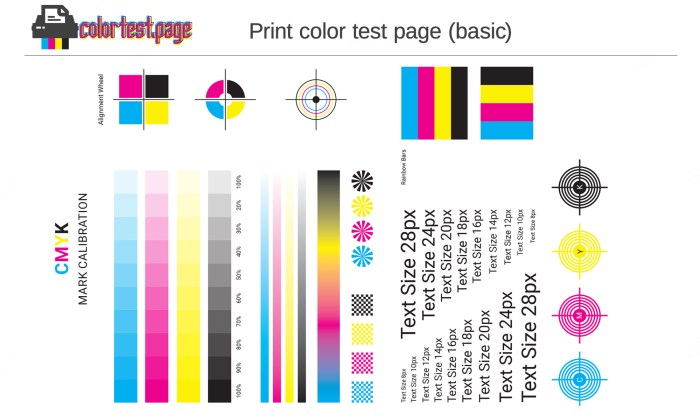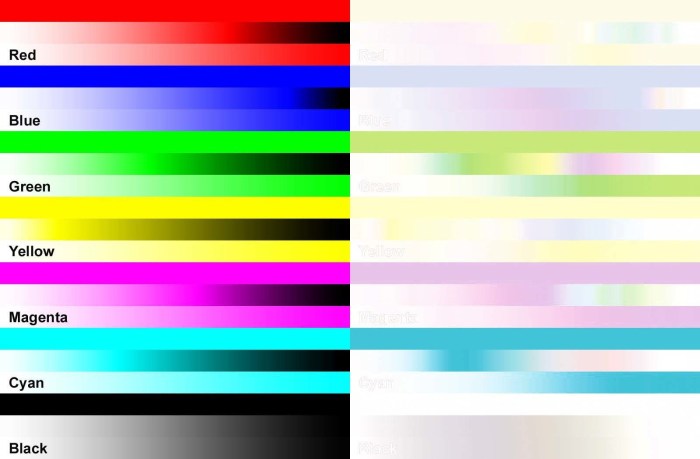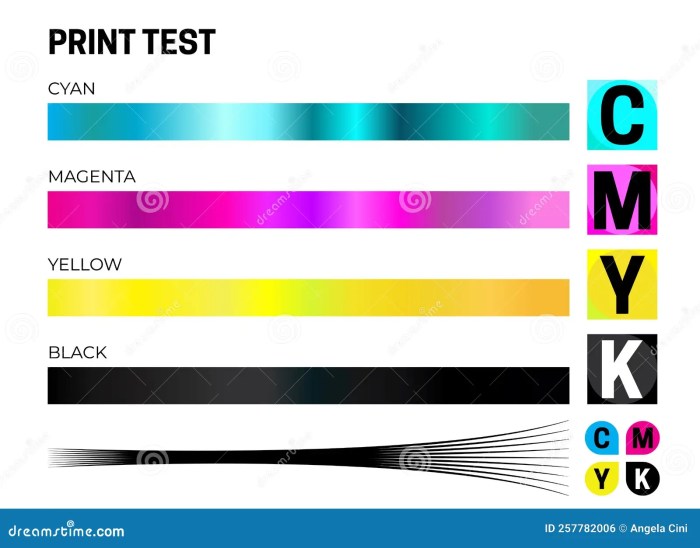Printer Color Test Page Functionality

A printer color test page serves as a crucial diagnostic tool, allowing users to assess the printer’s color accuracy, identify potential issues, and ensure optimal print quality. It provides a visual representation of the printer’s capabilities, enabling quick detection of problems like clogged nozzles, incorrect color profiles, or hardware malfunctions. Regular use helps maintain consistent and high-quality output.The typical components found on a color test page are designed to thoroughly evaluate various aspects of printer performance.
These usually include a range of color swatches representing the printer’s color gamut, showing the full spectrum of colors it can reproduce. Grayscale gradients, progressing smoothly from black to white, demonstrate the printer’s ability to render subtle tonal variations. Text samples, often in various fonts and sizes, assess the sharpness and clarity of the printed text. Registration marks, small symbols or lines printed at the edges, help check for misalignment between color channels.
Finally, some test pages also include patterns to reveal banding or other print irregularities.
Inkjet vs. Laser Printer Color Test Pages
Inkjet and laser printers, while both producing printed output, employ vastly different technologies. This difference impacts the design and interpretation of their respective color test pages. Inkjet printers, using liquid ink, are often susceptible to nozzle clogging, leading to missing colors or banding in the output. Therefore, their test pages often emphasize the accurate reproduction of small details and smooth color gradients, making it easier to spot such irregularities.
Laser printers, on the other hand, utilize toner powder, generally producing sharper and more consistent results. Their color test pages might focus more on the accuracy of color reproduction across a broader range of colors and the overall sharpness of text and graphics. While both types include color swatches and grayscale gradients, the interpretation of the results differs based on the printing technology.
Sample Color Test Page Layout
A versatile color test page design could incorporate a grid layout. The top section could feature a series of large, clearly labeled color swatches, arranged systematically to represent a wide range of colors, from primary colors to complex shades. Below this, a grayscale gradient would transition smoothly from pure black to pure white, allowing for assessment of tonal range and smoothness.
Next, various text samples in different fonts and sizes would be included, demonstrating the clarity and sharpness of the printer’s text rendering capabilities. At the bottom of the page, registration marks could be placed in the corners to check for alignment issues. The layout should be simple, clear, and easily interpretable, providing a comprehensive evaluation of the printer’s performance across different aspects of color and text reproduction.
This layout would be suitable for both inkjet and laser printers, allowing for a consistent evaluation across different printing technologies.
Troubleshooting Printer Issues Using the Test Page: Printer Color Test Page
A color test page provides a valuable diagnostic tool for identifying and resolving various printer issues. By analyzing the printed results, you can pinpoint problems related to color accuracy, print quality, and potential hardware malfunctions. This allows for targeted troubleshooting, saving time and effort compared to a more general approach. This section details how to generate and interpret these test pages for common printer brands and how to use the information to solve common printing problems.
Before tackling any intricate coloring project, it’s always wise to run a printer color test page to ensure vibrant hues. This preliminary check is particularly important if you’re planning on using detailed coloring pages, such as the beautifully illustrated coloring pages of American Indians , to guarantee your colors pop and accurately reflect the artwork. A quick test page can save you time and frustration later by preventing unexpected color shifts or faded prints.
Printing a Color Test Page for Different Printer Brands
The method for printing a color test page varies slightly depending on the printer manufacturer. However, the general process involves accessing the printer’s settings or properties through the printer driver. For HP printers, navigate to “Print & Scan,” then select your printer and click “Printer properties”. Look for a “Maintenance” or “Utilities” tab containing the option to print a test page.
Canon printers often have a similar option under “Maintenance” or a similar section within the printer’s software interface. Epson printers may offer this feature within the “Tools” or “Settings” menu of their printer drivers. In each case, the specific menu location might differ based on the printer model and operating system. Consult your printer’s manual for precise instructions if needed.
Interpreting Color Test Page Results
The color test page typically displays a series of color swatches, grayscale gradients, and potentially text or patterns. Variations from expected results indicate potential problems. For example, faded or washed-out colors suggest a potential ink or toner cartridge issue, a problem with the print head, or a setting issue. Banding, which appears as horizontal streaks of color, often points to a problem with the print head or ink delivery system.
Uneven color distribution across the page might signal a problem with the printer’s internal mechanisms or the paper itself. Checking for misaligned colors or incorrect color representation compared to the on-screen preview can help identify problems with color profiles or driver settings.
Troubleshooting Faded Colors, Banding, and Other Print Quality Issues, Printer color test page
Based on the color test page analysis, you can begin troubleshooting. Faded colors frequently point towards low ink levels or clogged print heads. Check ink levels and replace cartridges as needed. For clogged print heads, the printer’s cleaning cycles (accessible through the printer driver) can often resolve the issue. Repeated cleaning cycles may be necessary.
Banding, characterized by horizontal streaks, often indicates a problem with the print head nozzles. Again, the cleaning cycle is a good first step. If the problem persists, a deeper cleaning, or potentially a print head replacement, might be necessary. Other print quality issues, such as blurry text or uneven color distribution, might require checking the printer’s settings, ensuring proper paper type is used, and verifying the printer’s internal mechanisms are functioning correctly.
Troubleshooting Guide Based on Common Color Test Page Output Problems
The following table summarizes common problems identified through a color test page and suggests troubleshooting steps:
| Problem | Possible Cause | Troubleshooting Steps |
|---|---|---|
| Faded Colors | Low ink/toner, clogged print heads, incorrect color settings | Check ink/toner levels, run print head cleaning cycles, adjust color settings |
| Banding | Clogged print heads, print head alignment issues | Run print head cleaning cycles, check print head alignment (if adjustable), consider print head replacement |
| Uneven Color Distribution | Paper issues, printer mechanism problems | Try different paper, check for any physical obstructions within the printer |
| Blurry Text | Incorrect resolution settings, damaged print head | Check and adjust print resolution, consider print head replacement |
| Misaligned Colors | Incorrect color profile, driver issues | Update printer drivers, check and adjust color profiles |
Color Profiles and Calibration with Test Pages
Color profiles are crucial for accurate color reproduction in printing. They act as a translator, informing the printer how to render colors on the page based on the colors displayed on your screen or within your design software. Without a properly configured color profile, the printed output will likely differ significantly from your digital expectations, leading to inconsistencies and frustration.
Understanding and managing color profiles is essential for achieving professional-quality print results.
A color test page provides a visual representation of how your printer handles a range of colors, allowing you to directly assess the accuracy of your chosen color profile and identify potential discrepancies between the digital source and the printed output.
Color Profile Standards Comparison
Several color profile standards exist, each with its strengths and weaknesses. The choice of profile often depends on the intended use and the capabilities of your printer and monitor. The following table compares some commonly used standards:
| Color Profile | Gamut Size | Typical Applications | Strengths |
|---|---|---|---|
| sRGB | Smaller | Web, general-purpose printing | Widely compatible, good for ensuring consistent color across various devices |
| Adobe RGB (1998) | Larger | Photography, high-end printing | Wider color gamut, better for capturing subtle color variations |
| Pantone | Specific spot colors | Branding, precise color matching | Guaranteed color consistency across different print runs and printers |
| CMYK | Printer-dependent | Offset printing, commercial printing | Directly relates to the printer’s ink system |
Assessing Printer Color Profile Accuracy
A color test page, often containing a range of color swatches, grayscale gradients, and color bars, is indispensable for evaluating a printer’s color profile accuracy. By comparing the printed colors on the test page to the digital source, you can visually identify any color shifts, banding, or inconsistencies. For example, if a specific shade of blue appears significantly different on the printed page compared to the digital representation, it indicates a potential issue with the color profile’s interpretation or the printer’s color reproduction capabilities.
Discrepancies in grayscale gradients can highlight problems with tonal accuracy.
Calibrating a Printer’s Color Profile Using a Test Page
Calibrating a printer’s color profile involves adjusting its settings to achieve a closer match between the digital and printed colors. While this process often involves specialized software, a color test page plays a vital role in evaluating the effectiveness of the calibration. The steps typically involve:
- Printing a color test page using the current color profile.
- Visually comparing the printed page to the digital source, noting any color discrepancies.
- Adjusting the printer’s color settings (often through driver settings or color management software) based on the observed discrepancies.
- Printing another test page to evaluate the impact of the adjustments.
- Repeating steps 3 and 4 until satisfactory color accuracy is achieved.
Software and Settings Affecting Color Test Pages

The accuracy and reliability of a printer color test page depend heavily on various software and hardware settings. Understanding these influences is crucial for achieving optimal color reproduction and troubleshooting printing problems. Factors such as printer driver settings, paper type, and print resolution all play a significant role in the final output.
Printer Driver Settings and Color Test Pages
Printer drivers act as the intermediary between your computer’s operating system and your printer. They contain numerous settings that directly impact color management. For instance, the color profile selected within the driver dictates how the printer interprets and renders colors. Using a profile that matches your printer and ink type is essential for accurate color reproduction. Incorrect profile selection can lead to significant color shifts, making the test page appear faded, oversaturated, or with inaccurate color representation across the spectrum.
Other settings like color mode (e.g., RGB, CMYK) and print quality also influence the results. Choosing a higher quality setting often improves the precision and detail shown in the test page’s color gradients and patches.
Paper Type’s Influence on Color Test Page Appearance
The type of paper used significantly affects the final appearance of colors on a test page. Different paper types have varying levels of absorbency, brightness, and texture. For example, glossy photo paper tends to produce more vibrant and saturated colors compared to matte paper, which may appear slightly muted. The paper’s brightness also impacts color perception; brighter paper can enhance the apparent intensity of colors, while duller paper may result in subdued tones.
Even the paper’s weight can affect color, with heavier papers potentially exhibiting richer, more solid colors due to their higher density. Using the wrong paper type can lead to inaccurate color representation on the test page, making it difficult to assess the printer’s true capabilities.
Print Resolution and Color Accuracy on Test Pages
Print resolution, measured in dots per inch (DPI), directly impacts the detail and smoothness of color gradients and transitions visible on the test page. Higher resolutions (e.g., 600 DPI or higher) generally produce smoother color transitions and finer details, resulting in a more accurate representation of the color spectrum. Lower resolutions (e.g., 300 DPI or lower) may lead to banding or noticeable pixelation in color gradients, obscuring subtle color differences and reducing the overall accuracy of the test page’s color representation.
The difference becomes particularly noticeable in areas with smooth color transitions or fine details. For example, a smooth gradient from red to yellow might appear banded or stepped at lower resolutions, while at higher resolutions it would be much smoother.
Adjusting Printer Settings for Optimized Color Reproduction
Analyzing the color test page allows for targeted adjustments to printer settings. If the test page shows a color cast (e.g., a consistent shift towards a specific color), you might need to adjust the color balance settings within the printer driver. If colors appear too pale or washed out, increasing the ink saturation or adjusting the print quality might be necessary.
Conversely, if colors appear oversaturated, reducing ink saturation or using a different paper type could improve the result. The test page provides a visual reference for fine-tuning color settings until the desired level of accuracy is achieved. This iterative process, using the test page as feedback, is key to optimizing color reproduction for specific projects and paper types.
Advanced Color Management and Test Pages

Understanding advanced color management techniques is crucial for achieving accurate and consistent color reproduction across different devices and workflows. Color test pages play a vital role in this process, providing a visual representation of a printer’s capabilities and allowing for fine-tuning of color settings.
Color Gamut and its Relevance to Color Test Pages
A color gamut represents the range of colors a device can reproduce. It’s essentially the boundaries of the color space a device can access. For example, a printer’s color gamut defines the spectrum of colors it can print, while a monitor’s gamut defines the colors it can display. Color test pages are designed to visually demonstrate the printer’s gamut, revealing which colors within a given color space it can accurately reproduce and which it cannot.
By comparing the printed test page to a digital version, discrepancies in color reproduction become readily apparent, highlighting areas needing adjustment. This helps identify limitations and ensures consistent color across different stages of the printing process.
Visual Representation of Printer and Monitor Color Gamuts
Imagine two irregularly shaped, overlapping areas on a three-dimensional color space graph. One area represents the printer’s gamut, the other the monitor’s gamut. The printer gamut might be smaller and more irregularly shaped, perhaps with a noticeable absence of vibrant blues and greens in certain areas, reflecting its limitations in reproducing the full spectrum of colors. The monitor gamut, while potentially larger, will likely still be limited in its representation of highly saturated colors.
The overlapping area signifies the colors both the printer and the monitorcan* reproduce accurately. The areas outside the overlap show colors that are either displayed accurately on the monitor but not printable, or printed accurately but not displayed accurately on the monitor. The difference in size and shape highlights the discrepancy between the two devices’ color reproduction capabilities. The non-overlapping portions represent colors outside the capabilities of one or both devices.
For instance, a highly saturated green might be easily displayed on a high-end monitor but fall outside the printer’s color capabilities, resulting in a duller, less vibrant reproduction.
Color Test Pages in Professional Printing Workflows
In professional photography and graphic design, color test pages are indispensable tools. Photographers use them to ensure accurate color reproduction of their images in print. They compare the printed test page to the original digital image to identify any color shifts or discrepancies. Graphic designers use color test pages to verify that the colors used in their designs are accurately reproduced on the target printing device.
This is particularly important for projects requiring precise color matching, such as corporate branding materials or high-end print advertising where maintaining brand consistency across different print runs is critical. Consistent use of color test pages allows for iterative adjustments to color profiles and printer settings, leading to high-quality, accurate color reproduction in the final printed product. The cost of reprinting due to color inconsistencies far outweighs the time spent on color calibration using test pages.
Generating Custom Color Test Pages
Several methods exist for generating custom color test pages tailored to specific needs. Dedicated color management software packages often include features for creating custom test pages. These programs allow users to define specific color palettes, patterns, and color gradients to be included in the test page. Additionally, many online tools and resources provide templates and generators that allow users to create customized test pages with specific color swatches or color scales.
These can be adapted to test specific color ranges or simulate real-world scenarios, such as a range of skin tones or a particular Pantone color palette. Alternatively, scripting languages like Python, with appropriate libraries, can be used to generate custom test pages based on user-defined parameters, offering a high degree of control and flexibility. This approach is particularly useful for testing a large number of colors or complex color variations.
